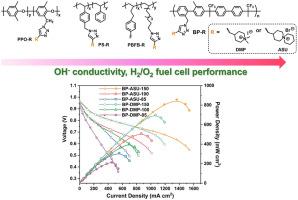不含芳基醚的聚苯乙烯基阴离子交换膜与 N-环季铵结合,可提高碱性燃料电池的性能
IF 8.4
1区 工程技术
Q1 ENGINEERING, CHEMICAL
引用次数: 0
摘要
选择合适的聚合物骨架对于开发具有高离子传导性和强大化学稳定性的阴离子交换膜(AEM)至关重要。在本研究中,我们合成了含有耐碱 N 环阳离子(即二甲基哌啶鎓(DMP)或 6-氮杂螺[5.5]十一烷(ASU))的刚性和化学惰性无芳基聚苯乙烯基聚合物骨架,作为高性能 AEM。该过程包括几个关键步骤:超酸催化弗里德尔-卡夫斯缩聚、溴甲基化、叠氮化和 Cu(I)-mediated 叠氮-炔环化。与基于聚烯烃的共聚物相比,合成的 BP-ASU(DMP)-x 共聚物具有出色的成膜能力,可提供坚固耐用的 AEM。由于疏水性骨架与亲水性阳离子之间存在明显的不相容性,BP-ASU(DMP)-x 膜呈现出清晰的微相分离形态,因此具有极高的氢氧化物电导率,在 80 °C 的水中可达 157.2 mS cm-1。更重要的是,BP-ASU-150 膜在 80 °C 的 1 M NaOH 溶液中浸泡 4000 小时后,没有发生化学降解,电导率保持率高达 97%。与聚(2,6-二甲基-1,4-苯基氧化物)(PPO)和聚烯烃基同类产品相比,BP-ASU-150 所具有的出色碱性稳定性与不含芳基醚的聚亚苯基和碱性稳定的 N-环阳离子有关,凸显了聚合物骨架对 AEM 材料的重要性。最后,在单个 H2/O2 AEMFC 中组装了所有含有 N 环阳离子的聚苯基 AEM,其中 BP-ASU-150 膜在电流密度为 1363 mA cm-2 时的峰值功率密度(PPD)为 860.4 mW cm-2。我们得出的结论是,BP-ASU(DMP) AEM 在各种指标上都表现出了卓越的性能,这归功于聚苯聚合物卓越的稳定性和坚固性,凸显了它们作为高性能 AEM 材料骨架的潜力。本文章由计算机程序翻译,如有差异,请以英文原文为准。

Aryl-ether-free polyphenylene-based anion exchange membranes incorporating N-cyclic quaternary ammoniums for enhanced alkaline fuel cell performance
Selecting appropriate polymer backbones is crucial for the advancement of anion exchange membranes (AEMs) that exhibit both high ionic conductivity and robust chemical stability. In this study, we synthesized rigid and chemically inert aryl-ether-free polyphenylene-based polymer backbones containing alkaline-resistant N-cyclic cations, i.e. dimethyl piperidinium (DMP) or 6-azonia-spiro[5.5]undecane (ASU), as high-performance AEMs. The procedure encompassed several key steps: superacid-catalyzed Friedel-Crafts polycondensation, bromomethylation, azidation, and Cu(I)-mediated azide-alkyne cycloaddition. The synthesized BP-ASU(DMP)-x copolymers demonstrated excellent film-forming capabilities to afford robust AEMs as compared to polyolefin-based counterparts. Owing to the significant incompatibility between the hydrophobic backbones and the hydrophilic cations, the BP-ASU(DMP)-x membranes exhibited a well-defined microphase-separated morphology, resulting in exceptionally high hydroxide conductivity, up to 157.2 mS cm−1 at 80 °C in water. More importantly, BP-ASU-150 membrane exhibited no chemical degradation and a conductivity retention of >97 % when immersed in 1 M NaOH solution at 80 °C for 4000 h. Compared to the poly(2,6-dimethyl-1,4-phenylene oxide) (PPO) and polyolefin-based counterparts, the achieved outstanding alkaline stability is related to aryl-ether-free polyphenylene and alkali-stable N-cyclic cations, highlighting the importance of polymer backbones for AEM materials. Finally, all the polyphenylene-based AEMs with incorporated N-cyclic cations were assembled in single H2/O2 AEMFCs, with the BP-ASU-150 membrane demonstrating a peak power density (PPD) of 860.4 mW cm−2 at a current density of 1363 mA cm−2. We concluded that the BP-ASU(DMP) AEMs demonstrated superior performance across various metrics due to exceptional stability and robustness of polyphenylene polymers, highlighting their potential as backbones for high-performance AEM materials.
求助全文
通过发布文献求助,成功后即可免费获取论文全文。
去求助
来源期刊

Journal of Membrane Science
工程技术-高分子科学
CiteScore
17.10
自引率
17.90%
发文量
1031
审稿时长
2.5 months
期刊介绍:
The Journal of Membrane Science is a publication that focuses on membrane systems and is aimed at academic and industrial chemists, chemical engineers, materials scientists, and membranologists. It publishes original research and reviews on various aspects of membrane transport, membrane formation/structure, fouling, module/process design, and processes/applications. The journal primarily focuses on the structure, function, and performance of non-biological membranes but also includes papers that relate to biological membranes. The Journal of Membrane Science publishes Full Text Papers, State-of-the-Art Reviews, Letters to the Editor, and Perspectives.
 求助内容:
求助内容: 应助结果提醒方式:
应助结果提醒方式:


